![]()
![]()
![]()
![]()
![]()
![]()
![]()
![]()
![]()
![]()
![]()
![]()
![]()
![]()
![]()
![]()
![]()
![]()
![]()
![]()
![]()
![]()
![]()
![]()
American Flyer S Scale Flatcars (1 of 6)
The TM Guide lists three and a half pages of
Gilbert flatcars, 56 in all and many had variations. Between
1981 and 2006, Lionel made 35 more flatcars under their American
Flyer name. Because there are so many, I have split them up
over six web pages:
Gilbert flatcars #605 through #714 are
on this page
#715 through #948 are on page
2
#956 through #24564 are on page
3
#24565 through #25515 are on page
4
Lionel flatcars #9000
through #48531 are on page
5
#48532 and above are on page
6
The large pictures on this
page are of cars in the collection of The Upstairs Train.
Unless otherwise specified, the smaller ones are from ebay
auctions I didn't win.
If you have a picture that you would
like to share with the world of any of the cars not shown here (or
a better picture of one that is shown!), email them to me:
theupstairstrain@yahoo.com. Click
here for a list of the pictures
I need to complete the Gallery.
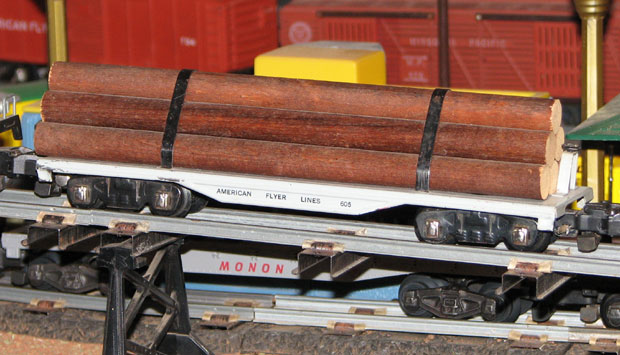
#605 gray sheet-metal flatcar with log load made in 1953.
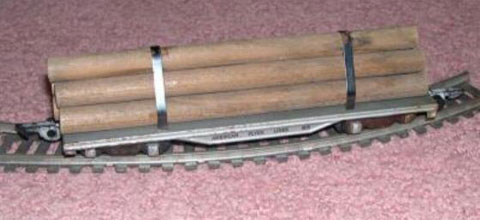
A #605 log car painted silver was
also made in 1953.
(Photo courtesy of an anonymous donor.)

#609 sheet-metal flatcar with girder
load made in 1953.
(Photo courtesy of an anonymous donor.)

#627 Flatcar with girder load made in
1946-1947 with gray plastic base.
(Photo courtesy of Mark
Preman of AmericanFlyerTrains.com.)

It was also made with a white plastic
base in 1946-1947.
Norice that the girder is yellow rather than
orange.
(Photo courtesy of Don Hasenzahl.)

#627 Flatcar with girder load made in
1947-1950 with painted die-cast base.
The die-cast #627
Flatcar was also made with American Flyer Lines rather than C&NWRY
in 1950.

Yellow girders came on the diecast
cars, too.
(Photo courtesy of Gary Good.)
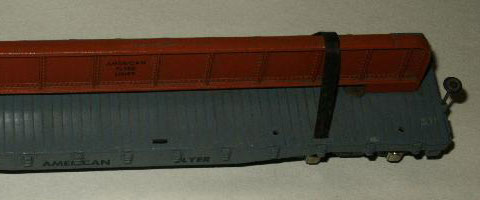
Here's an oddball for you: this one
has holes for a Work and Boom Car cabin and fences!
(Photo
courtesy of Don Hasenzahl.)
What it looks like is the base for a #645 Work and
Boom Car with a girder load mounted on it. Some of the #627
Flatcars made in 1950 read "American Flyer Lines" but
none read "American Flyer" like the #645. And the
straps that hold the girder aren't taught like they are on other
#627s.
The question is whether it came from the factory
that way. Don is convinced it did because the holes for the
caboose shed have the factory gray paint inside the holes with no
evidence that a pin had ever been in any of the holes to mount a
shed. Further, the straps are the same shiny black metal and
are the same exact width and thickness as the originals on some of
his other girder cars. The repro straps are dull black
plated metal and are a little thicker than the originals.

#628 flatcar with log load on an
unpainted white plastic base made in 1946.
(Photo courtesy of
Don Hasenzahl.)
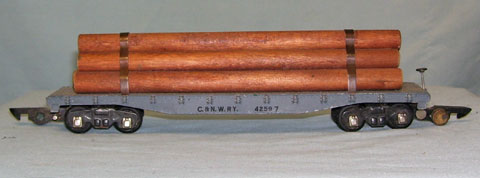
It was also made on an unpainted gray
plastic base in 1946.
(Photo courtesy of Michael
J. Whisman.)
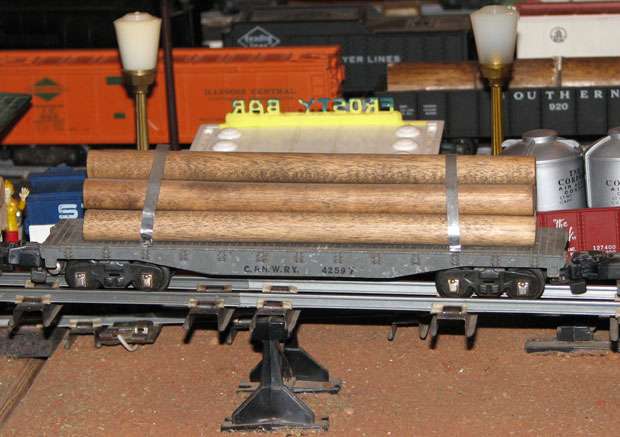
#628 gray diecast flatcar with log load made in 1947-1953.

I also have a #628 Flatcar without the log load made in 1947-1953.
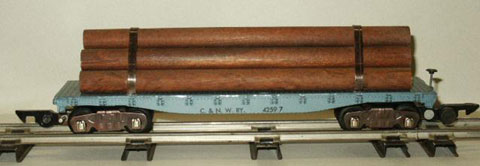
#628 Flatcar with log load on a
metallic blue base made in 1953.
(Photo courtesy of Don
Hasenzahl.)

It was also made on a Plaskon
(pressed wood) base in 1952-1953.
(Photo courtesy of an
anonymous donor.)

#636 Erie Wire Reel Flatcar made in 1948-1953.

It was also made with a blue-gray
base.
(Photo courtesy of an anonymous donor.)

An unusual variation on the blue-gray
base:
the reel is a mustard yellow and the lower lettering is
smaller than usual.
(Photo courtesy of Don Hasenzahl.)
Because an increasing number of authentic-looking reproductions are popping up, I asked Don whether he was sure the car came this way from the Gilbert factory. He replied, "The print on the reel faces is without question machine stamped onto the paint. Gilbert's printing was done by machine, not rubber stamped. If this was done post factory at that time of “early reproductions” it would have been either done with dry transfers or rubber stamps which would make the small print irregular on the edges and not uniform." Here's a close-up of the reel face so you can see what he's talking about.
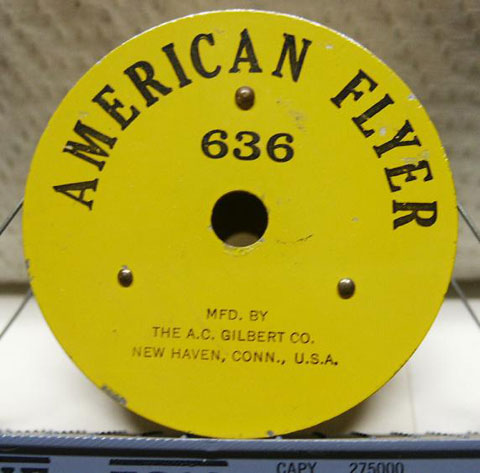

A rare version with a
Bakelite/Plaskon base made in 1953.
You can see the difference
in the way the wires are tied down and the lack of steps.
(Photo
courtesy of an anonymous donor.)
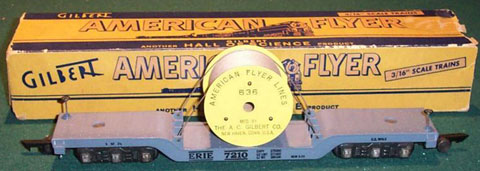
Most say simply "American Flyer"
on the reel; this is the very rare version with "American
Flyer Lines".
(Photo courtesy of an anonymous donor.)
Four different circus cars made in
1950-1953 shared the same #643.
Each carries a tractor truck
and two cage trailers with an animal inside.
These plastic
trucks and cages broke easily; many reproductions have been made
to replace them.
Be aware that any car you buy may carry
reproductions.
They appeared in only one set, the #5002T
Circus Train.

The
first, made only early in 1950, was a yellow diecast flatcar with
boxcar door guides
to hold the wheels of the trailers.
(Photo
courtesy of John Eichmann of the Rocky
Mountain Hi-Railers.)

Early in 1950, Gilbert switched to a
black-painted block of wood to hold the wheels of the
trailers.
(Photo courtesy of Jay
Mackro.)

Early in 1950, Gilbert switched to a
black-painted block of wood to hold the wheels of the
trailers.
This version was made through 1952.
(Photo
courtesy of an anonymous donor.)
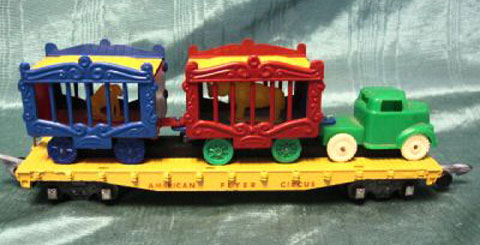
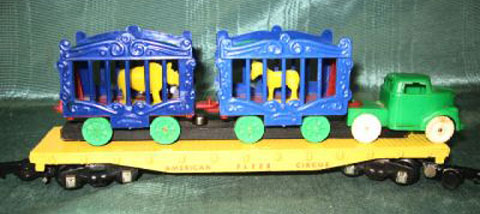
There are many different color
schemes in the tractor, trailers, and animals.
The 1980 edition
of Greenberg's Guide lists the known combinations.
(Both photos
courtesy of Wanted
Antiques Inc.)
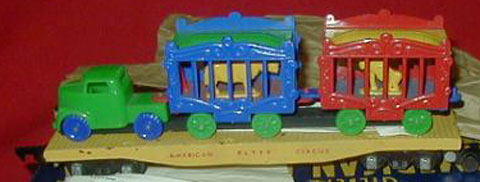
In 1952 & 1953, Gilbert made this
flatcar on a yellow Plaskon (pressed wood) base.
(Photo
courtesy of an anonymous donor.)
They also made it on a
yellow Bakelite base in 1952 & 1953.

The fourth variation was a red
diecast flatcar with yellow lettering.
None of my books tells
what year(s) this was made.
(Photo courtesy of an anonymous
donor.)

#648 Track Cleaning Car made from 1952 to 1954.

It was also made in tuscan.
(Photo
courtesy of an anonymous donor.)
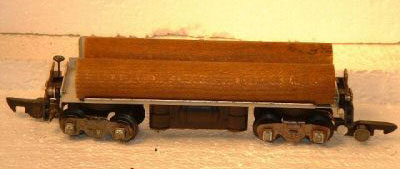
#714 Log Unloading Car made in 1951-1954.
Over the years, Gilbert made four
different kinds of couplers, three of which are common and
familiar to most American Flyer owners: link, knuckle, and Pike
Master. The fourth, the so-called "solid knuckle
coupler," was short-lived and not used on very many cars.
Lionel later came up with its own version of knuckle coupler.
American Flyer has therefore gone through five generations
of couplers. Because there seem
to be a lot of people confused by this, I created a page to show
the differences. Click the picture below for more detail.
It takes time and money to maintain a
website like this. If this site is interesting and helpful
to you, please contribute financially to its ongoing success.
You may send
a contribution via PayPal using
theupstairstrain@yahoo.com as the payee. Both credit card and
direct transfers would be greatly appreciated. Thank you very
much.
If you or your friends have some American Flyer
trains and would like them to go to a nice home where they'll be
loved and cared for, this is the place! Email me:
theupstairstrain@yahoo.com. See my Wish
List for the items I need most.
Thank you very much.
On the other side of the coin, I post
pictures from time to time on my For
Sale page of surplus items I have for
sale.
This gallery will continue to grow and become more
comprehensive as I collect more cars and as visitors like you send
me pictures of the cars I don't yet have. If you have a car
that you would like to share with the world, email me a picture:
theupstairstrain@yahoo.com. Click
here for a list of the pictures I need
to complete the Gallery.
The books I am using for reference
are listed in the Bibliography
page. All the writing and all the pictures on
this website are, however, my own, except where cited. No
copyrighted materials have been included and all pictures provided
by others are used by permission.
Now show me:
The Gilbert Gallery Home Page
Engines
Passenger Cars
Freight Cars
Freight Sets
Work Cars
Accessories
Infrastructure Gallery
Christmas Cars
Boxcars
Refrigerator Cars
Stock Cars
Hopper Cars
Gondolas
Tank Cars
Flatcars
Aquarium Cars
Autorack Cars
Mint Cars
Cabooses
Pictures Needed
Useful Links
For Sale
Wish List
Bibliography
The
Upstairs Train
